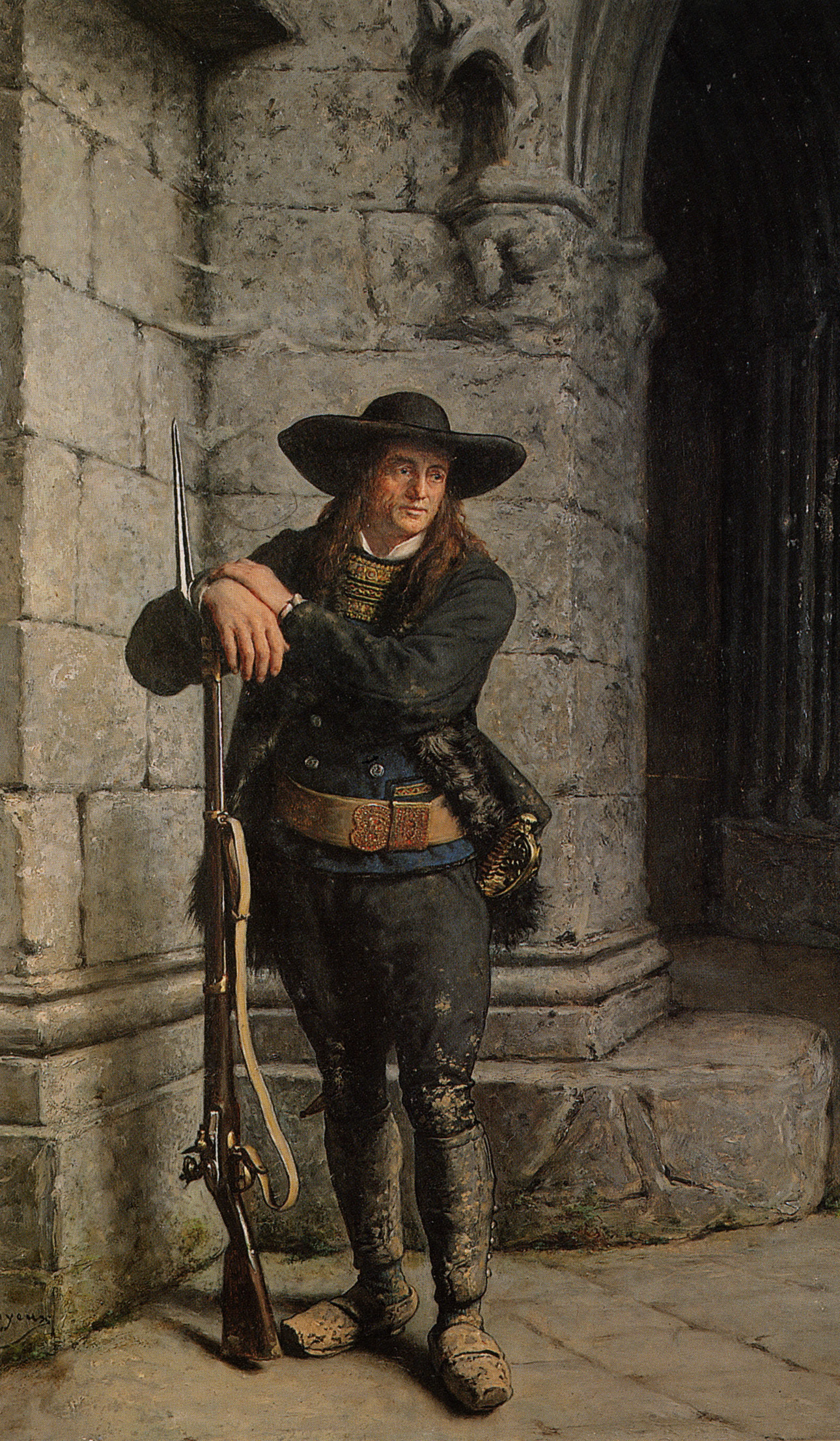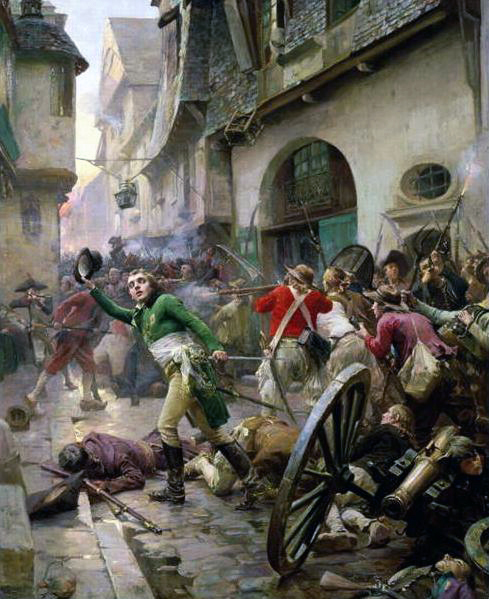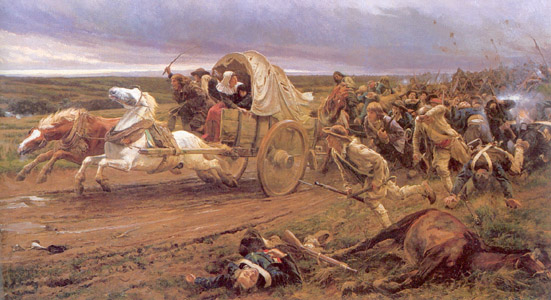|
Battle Of Fougères
The battle of Fougères was a battle on 3 November 1793 at Fougères, during the Virée de Galerne. It was a Vendéen victory. The Vendéens (on their way from taking Mayenne) decided to march on Saint-Malo to make contact with the British and, recently joined by the Chouans, marched on Fougères on the way. Realising the danger, the Republicans prepared to defend the city and castle, with adjudant général Brière gathering 6,000 National Guard National Guard is the name used by a wide variety of current and historical uniformed organizations in different countries. The original National Guard was formed during the French Revolution around a cadre of defectors from the French Guards. Nat ...s and soldiers from line regiments and inspecting the castle's defences. Many administrators chose to leave the city and flee towards Rennes, with some exceptions staying put, such as mayor Lesueur. Course After the battle Retreat Fougères reoccupied by the Republicans Bibliogr ... [...More Info...] [...Related Items...] OR: [Wikipedia] [Google] [Baidu] |
War In The Vendée
The war in the Vendée (french: link=no, Guerre de Vendée) was a counter-revolution from 1793 to 1796 in the Vendée region of France during the French Revolution. The Vendée is a coastal region, located immediately south of the river Loire in Western France. Initially, the revolt was similar to the 14th-century Jacquerie peasant uprising, but the Vendée quickly became counter-revolutionary and Royalist. The revolt headed by the newly-formed Catholic and Royal Army was comparable to the Chouannerie, which took place in the area north of the Loire. While elsewhere in France the revolts against the were repressed, an insurgent territory, called the by historians, formed south of the Loire-Inférieure (Brittany), south-west of Maine-et-Loire (Anjou), north of Vendée and north-west of Deux-Sèvres ( Poitou). Gradually referred to as the "Vendeans", the insurgents established in April a " Catholic and Royal Army" which won a succession of victories in the spring and summ ... [...More Info...] [...Related Items...] OR: [Wikipedia] [Google] [Baidu] |
Fougères
Fougères (; br, Felger; Gallo: ''Foujerr'') is a commune and a sub-prefecture of the Ille-et-Vilaine department in the region of Brittany in northwestern France. As of 2017, Fougères had 20,418 inhabitants. The Fougères area comprises approximately 88,000 inhabitants and is currently growing, unlike the town centre. History Toponymy Fougères is a town on the edge of Brittany, Maine and Normandy and is named after a fern (see also ''fougère''), or from ''fous'' which means ''fossé'' ("gap"). The town of Fougères is mentioned in the chorus of the song La Blanche Hermine by Gilles Servat. The author uses it as a symbol of the Breton resistance where it is adjacent to the town of Clisson in the Loire-Atlantique. Fougères is historically, since the arrival of Latin in Armorica, a region where Gallo is spoken. In Gallo, Fougères translates to ''Foujerr'' while its Breton name is ''Felger''. Entry signs to the agglomeration have carried the Breton name for several ye ... [...More Info...] [...Related Items...] OR: [Wikipedia] [Google] [Baidu] |
French Revolutionary Army
The French Revolutionary Army (french: Armée révolutionnaire française) was the French land force that fought the French Revolutionary Wars from 1792 to 1804. These armies were characterised by their revolutionary fervour, their poor equipment and their great numbers. Although they experienced early disastrous defeats, the revolutionary armies successfully expelled foreign forces from French soil and then overran many neighboring countries, establishing French client republic, client republics. Leading generals included Napoleon Bonaparte, Jean-Baptiste Jourdan, André Masséna and Jean Victor Marie Moreau. As a general description of French military forces during this period, it should not be confused with the "revolutionary armies" (''armées révolutionnaires'') which were paramilitary forces set up during the Reign of Terror, Terror. Formation As the ''Ancien Regime'' gave way to a constitutional monarchy, and then to a republic, 1789–92, the entire structure of France ... [...More Info...] [...Related Items...] OR: [Wikipedia] [Google] [Baidu] |
Armée Catholique Et Royale
The Catholic and Royal Armies (french: Armées catholiques et royales) is the name given to the royalist armies in western France composed of insurgents during the war in the Vendée and the Chouannerie, who opposed the French Revolution. Catholic and Royal Army of Vendée The Catholic and Royal Army of Vendée was composed of the three Vendéen armies although that of lower Poitou joined only occasionally. During the year 1793, the Vendéen army was distinguished into sub-armies: The ''army of Charette'' in the Marais breton, the Catholic and Royal Army of Anjou and Haut-Poitou, and that of ''Bas-Poitou and Retz country'', south of the Loire. The Chouans of the north of the Loire who joined the Vendéens during the Virée de Galerne were named ''Catholic and Royal Army of Bas-Anjou and of Haute-Bretagne''. In reality, those armies were simply groups of fluctuating insurgents led by a chief who had authority over people following his beliefs. The only units with a quasi- ... [...More Info...] [...Related Items...] OR: [Wikipedia] [Google] [Baidu] |
Chouans
Chouan ("the silent one", or "owl") is a French nickname. It was used as a nom de guerre by the Chouan brothers, most notably Jean Cottereau, better known as Jean Chouan, who led a major revolt in Bas-Maine against the French Revolution. Participants in this revolt – and to some extent French anti-Revolutionary activists in general – came to be known as ''Chouans'', and the revolt itself came to be known as the ''Chouannerie''. Origin of the word Jean Cottereau and his brothers all inherited the nickname Chouan from their father, a clog merchant and ''homme honorable'' from Saint-Berthevin in Mayenne, on the border with Brittany. One view is that this nickname originated from his talent for impersonating the cry of the owl (''chouette'' in French), or specifically the tawny owl, which was called ''chouan'' in old French (French ''chat-huant''), a designation that survived in the western ''langue d'oïl'' dialect spoken in Mayenne. According to another authority, the only r ... [...More Info...] [...Related Items...] OR: [Wikipedia] [Google] [Baidu] |
Henri De La Rochejaquelein
Henri du Vergier, De la Rochejacquelein, comte de la Rochejaquelein (30 August 1772 – 28 January 1794) was the youngest general of the House of Bourbon, Royalist War in the Vendée, Vendéan insurrection during the French Revolution. At the age of 21, he served as commander-in-chief of the Catholic and Royal Army. Biography Early activities Born in the Château de la Durbellière, Saint-Aubin-de-Baubigné, near Mauléon, Deux-Sèvres, Châtillon, La Rochejaquelein joined the Royal Polish Regiment, of which his father was colonel, in 1787. In February 1789 he became a member of the Flanders regiment of chasseurs. In March 1792 he became a member of the Constitutional Guard, charged with protecting the List of French monarchs, King of France. He fought for the first time defending the Tuileries Palace on the 10 August (French Revolution), 10 August 1792 attack, as an officer of the Constitutional Guard of King Louis XVI of France, Louis XVI. Returning to his home province, he ... [...More Info...] [...Related Items...] OR: [Wikipedia] [Google] [Baidu] |
Virée De Galerne
The Virée de Galerne was a military operation of the War in the Vendée during the French Revolutionary Wars across Brittany and Normandy. It takes its name from French ''virée'' (turn) and Breton ''gwalarn'' (northwest wind). It concerns the Vendean army's crossing of the river Loire after their defeat in the Battle of Cholet on 17 October 1793 and its march to Granville in the hope of finding reinforcements there from England. Unable to take Granville on 14 November 1793, it fell back towards Savenay (23 December 1793) where it was completely destroyed by Republican troops under Kléber. The battle of Savenay marked the end of what would come to be called the '' First War in the Vendée''. Course Rout at Cholet On 17 October 1793, the Republican Army of the West coordinated an attack on the Vendéen Royalists and squeezed them into a pocket at Cholet. Encircled, the Catholic and Royal Armies of Anjou and Haut-Poitou desperately attempted to resist but were decisive ... [...More Info...] [...Related Items...] OR: [Wikipedia] [Google] [Baidu] |
Mayenne, Mayenne
Mayenne (, ) is a commune in the Mayenne department, northwestern France. It is a subprefecture of the department. It is situated on the river Mayenne. History In medieval times, the town was the seat of the Lords of Mayenne. The town originated when Juhel II of Mayenne built a monastery near the gate of the pre-existing castle, which led to the formation of the settlement. Mayenne was besieged twice during the French Wars of Religion, in 1574 and 1590, and suffered substantial damage. It was rebuilt and re-embellished in the following century thanks to the help of Cardinal Mazarin. It however suffered from plague in 1707. On 9 June 1944, during World War II, it was bombed by the RAF, which caused heavy damage and numerous casualties. Population Main sights * The Château, built in the 10th century (900-920) is an exceptional example of a palace dating from the Carolingian period. Reception room, tower and cellar are remarkably well preserved. The dungeon and ramparts, bu ... [...More Info...] [...Related Items...] OR: [Wikipedia] [Google] [Baidu] |
Saint-Malo
Saint-Malo (, , ; Gallo: ; ) is a historic French port in Ille-et-Vilaine, Brittany, on the English Channel coast. The walled city had a long history of piracy, earning much wealth from local extortion and overseas adventures. In 1944, the Allies heavily bombarded Saint-Malo, which was garrisoned by German troops. The city changed into a popular tourist centre, with a ferry terminal serving the Channel Islands of Jersey and Guernsey, as well as the Southern English settlements of Portsmouth, Hampshire and Poole, Dorset. The famous transatlantic single-handed yacht race Route du Rhum, which takes place every four years in November, is between Saint Malo and Pointe-à-Pitre in Guadeloupe. Population The population in 2017 was 46,097 – though this can increase to up to 300,000 in the summer tourist season. With the suburbs included, the metropolitan area's population is approximately 133,000 (2017). The population of the commune more than doubled in 1967 with the merging ... [...More Info...] [...Related Items...] OR: [Wikipedia] [Google] [Baidu] |
National Guard (France)
The National Guard (french: link=no, Garde nationale) is a French military, gendarmerie, and police reserve force, active in its current form since 2016 but originally founded in 1789 during the French Revolution. For most of its history the National Guard, particularly its officers, has been widely viewed as loyal to middle-class interests. It was founded as separate from the French Army and existed both for policing and as a military reserve. However, in its original stages from 1792 to 1795, the National Guard was perceived as revolutionary and the lower ranks were identified with sans-culottes. It experienced a period of official dissolution from 1827 to 1830 but was reestablished. Soon after the Franco-Prussian War of 1870–71, the National Guard in Paris again became viewed as dangerously revolutionary, which contributed to its dissolution in 1871. In 2016, France announced the reestablishment of the National Guard for the second time, in response to a series of te ... [...More Info...] [...Related Items...] OR: [Wikipedia] [Google] [Baidu] |
Conflicts In 1793
Conflict may refer to: Arts, entertainment, and media Films * ''Conflict'' (1921 film), an American silent film directed by Stuart Paton * ''Conflict'' (1936 film), an American boxing film starring John Wayne * ''Conflict'' (1937 film), a Swedish drama film directed by Per-Axel Branner * ''Conflict'' (1938 film), a French drama film directed by Léonide Moguy * ''Conflict'' (1945 film), an American suspense film starring Humphrey Bogart * ''Catholics: A Fable'' (1973 film), or ''The Conflict'', a film starring Martin Sheen * ''Judith'' (1966 film) or ''Conflict'', a film starring Sophia Loren * ''Samar'' (1999 film) or ''Conflict'', a 1999 Indian film by Shyam Benegal Games * ''Conflict'' (series), a 2002–2008 series of war games for the PS2, Xbox, and PC * ''Conflict'' (video game), a 1989 Nintendo Entertainment System war game * '' Conflict: Middle East Political Simulator'', a 1990 strategy computer game Literature and periodicals * ''Conflict'' (novel) ... [...More Info...] [...Related Items...] OR: [Wikipedia] [Google] [Baidu] |
Battles Of The War In The Vendée
A battle is an occurrence of combat in warfare between opposing military units of any number or size. A war usually consists of multiple battles. In general, a battle is a military engagement that is well defined in duration, area, and force commitment. An engagement with only limited commitment between the forces and without decisive results is sometimes called a skirmish. The word "battle" can also be used infrequently to refer to an entire operational campaign, although this usage greatly diverges from its conventional or customary meaning. Generally, the word "battle" is used for such campaigns if referring to a protracted combat encounter in which either one or both of the combatants had the same methods, resources, and strategic objectives throughout the encounter. Some prominent examples of this would be the Battle of the Atlantic, Battle of Britain, and Battle of Stalingrad, all in World War II. Wars and military campaigns are guided by military strategy, whereas bat ... [...More Info...] [...Related Items...] OR: [Wikipedia] [Google] [Baidu] |





